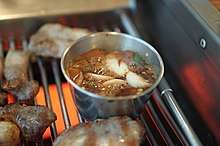Myeolchi-jeot
Myeolchi-jeot (멸치젓) or salted anchovies is a variety of jeotgal (salted seafood), made by salting and fermenting anchovies.[1] Along with saeu-jeot (salted shrimps), it is one of the most commonly consumed jeotgal in Korean cuisine. In mainland Korea, myeolchi-jeot is primarily used to make kimchi,[2] while in Jeju Island, meljeot (멜젓; myeolchi-jeot in Jeju language) is also used as a dipping sauce.[3] The Chuja Islands, located between South Jeolla and Jeju, are famous for producing the highest quality myeolchi-jeot.[4]
.jpg) | |
| Alternative names | Meljeot, salted anchovies |
|---|---|
| Type | Jeotgal |
| Place of origin | Korea |
| Main ingredients | Anchovies |
| Korean name | |
| Hangul | 멸치젓 |
|---|---|
| Revised Romanization | myeolchi-jeot |
| McCune–Reischauer | myŏlch'i-chŏt |
| IPA | [mjʌl.tɕʰi.dʑʌt̚] |
Names and etymology
Myeolchi-jeot (멸치젓) is a compound of myeolchi (멸치), the Korean word for anchovy (Engraulis japonicus), and jeot (젓), the word meaning salted fermented seafood.[5][6][7] Meljeot (멜젓) is also a compound, consisting of mel (멜), the Jeju name for anchovy, and jeot.[8] The Jeju word mel is cognate with the first syllable myeol of the Korean word myeolchi, whose second syllable -chi is a suffix attached to fish names.[9] Similar forms to meljeot also occur in mainland Korean dialects, including metjeot (멧젓) and mitjeot (밋젓) in Gyeongsang dialect.[10][11]
Preparation
The anchovies for Myeolchi-jeot are harvested along the southern coasts of the Korean Peninsula en masse. Myeolchi-jeot used in the process called gimjang are prepared with mature anchovies known as osari-myeolchi (flood tide anchovies), which are harvested in July and August. On Jeju Island, bigger anchovies harvested in the spring along the coasts of Seogwipo are made into meljeot.
Cleaned fresh anchovies are drained on sokuri (bamboo baskets), and salted with coarse salt weighing 15‒20% of the anchovies.[12] In an onggi (earthenware jar), the anchovies and salt are put in layers, with the uppermost layer being a thick layer of salt, to prevent the anchovies from coming in contact with the air.[2] The jar is sealed, and the salted anchovies are then allowed to ferment at 15–20 °C (59–68 °F) for two to three months in onggi (earthenware jars). Once the myeolchi-jeot has aged another couple of months, it becomes myeolchi-jeot-guk (anchovy extract).[12]
Culinary use

The liquid extract, made after around six months of fermentation of myeolchi-jeot, is filtered and boiled to be used in kimchi.[12] Alternatively, two parts myeolchi-jeot can be mixed with one part water, boiled over high heat, filtered, let set, and the upper, clear layer is used in kimchi.[2] The boiled and filtered myeolchi-jeot liquid may also used to flavor seaweed dishes.[13] Myeolchi-jeot made with boned anchovies are seasoned and eaten as banchan (side dish).[13]
In Geomun Island, where it is difficult to grow soybeans, the remaining solids and cloudy lower layer of liquid after extracting the clear, upper liquid (anchovy extract) from myeolchi-jeot is used to make myeoljang (anchovy paste).[13]
In Jeju Island, meljeot is used as dipping sauce for grilled pork. In summer, meljeot is used in blanched soybean leaf ssam (wrap), and in winter, napa cabbage leaves are dipped in meljeot.[3] Meljeot may also be eaten as banchan (side dish), either as is or seasoned with garlic and chili peppers.[3]
Gallery
 Myeolchi-aekjeot
Myeolchi-aekjeot
See also
- Anchovy essence – A thick, oily sauce of pounded anchovies and spices
- Anchovy paste – Fish paste food product using anchovies as a primary ingredient
- Bagoong monamon – Philppine food ingredient made by fermenting salted anchovies
- Budu – Fish sauce originating from east coast of Peninsular Malaysia
- Colatura di alici – An Italian fish sauce made from anchovies fermented in brine
- Fish sauce – A condiment made from fish coated in salt and fermented
References
- National Institute of Korean Language (30 July 2014). "주요 한식명(200개) 로마자 표기 및 번역(영, 중, 일) 표준안" (PDF) (in Korean). Retrieved 22 February 2017. Lay summary – National Institute of Korean Language.
- "Myeolchi-jeot" 멸치젓. Doopedia (in Korean). Doosan Corporation. Retrieved 24 June 2017.
- "Meljeot" 멜젓. Doopedia (in Korean). Doosan Corporation. Retrieved 24 June 2017.
- Cultural Properties Administration, MCPI (1984). Folkloric Studies Division, CHRI (ed.). Hanguk minsok jonghap josa bogoseo 한국민속종합조사보고서 [A General Survey Report of Korean Folklore] (PDF) (in Korean). 15. Seoul: Korea Herald. p. 197. ISBN 9788928503254. Retrieved 15 May 2008.
- "myeolchi-jeot" 멸치젓. Standard Korean Language Dictionary (in Korean). National Institute of Korean Language. Retrieved 23 June 2017.
- "myeolchi" 멸치. Standard Korean Language Dictionary (in Korean). National Institute of Korean Language. Retrieved 23 June 2017.
- "jeot" 젓. Standard Korean Language Dictionary (in Korean). National Institute of Korean Language. Retrieved 23 June 2017.
- "mel" 멜. Standard Korean Language Dictionary (in Korean). National Institute of Korean Language. Retrieved 23 June 2017.
- 홍, 윤표 (1 September 2006). "'가물치'와 '붕어'의 어원". National Institute of Korean Language (in Korean). Retrieved 4 June 2017.
- "metjeot" 멧젓. Standard Korean Language Dictionary (in Korean). National Institute of Korean Language. Retrieved 23 June 2017.
- "mitjeot" 밋젓. Standard Korean Language Dictionary (in Korean). National Institute of Korean Language. Retrieved 23 June 2017.
- "The Ingredients for Kimchi and Their Characteristics". Korea.net. Korean Overseas Information Service. Archived from the original on 28 March 2008. Retrieved 6 May 2008.
- 서, 혜경. "Myeolchi-jeot" 멸치젓. Encyclopedia of Korean Culture (in Korean). Academy of Korean Studies. Retrieved 24 June 2017.